
Humanities and Social Sciences
Materials in the various disciplines of the social sciences and humanities in all formats form in a very real sense the heart of the European collections of the Library of Congress. The Library's holdings include printed materials from the first printed book, the Gutenberg Bible of 1454-55, up to the most recent issues of newspapers describing the current events of the day--whether of local or world importance--recording the turmoil caused by the reunification of Germany, the emergence of democracy in the former communist countries of Eastern Europe and the former Soviet Union, the war in Bosnia, and the latest developments in the economic, political, and social integration of the European Union.
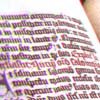 A
detail from the Gutenberg Bible (Mainz,1454-55), the first book prin
ted with movable type. The Library of Congress copy, acquired in 1930
as part of the Vollbehr Collection of incunabula, is one
of three perfect vellum copies of the Gutenberg Bible. (
Rare Book and Special Collections Division)
A
detail from the Gutenberg Bible (Mainz,1454-55), the first book prin
ted with movable type. The Library of Congress copy, acquired in 1930
as part of the Vollbehr Collection of incunabula, is one
of three perfect vellum copies of the Gutenberg Bible. (
Rare Book and Special Collections Division)
[Enlarged Version (172K)]
The European social science and humanities collections relate to all periods of civilization and history, beginning from the very dawn of European culture in the Stone Age as reported in the archaeological literature, and continuing through the great classical civilizations of Greece and Rome up to the present. In addition to print media, the Library collects social science and humanities materials in sound recordings, motion pictures, photographs, prints, maps, and other formats.
The classics were strongly represented both in the original Library of Congress collection and in Jefferson's library that replaced the volumes burned. In fact, one can even see Mr. Jefferson's handwritten corrections in the margins of Greek and Latin works that he sold to the Library. Today the holdings in the classics of the Library of Congress rank among those of major importance in the United States. A vast array of materials that range from texts of classical authors, translations, commentaries, and historical discussions to excavation reports and reference works to collections of inscriptions, vases, and sculptures are found in the Library's general collections. Latin, Greek, and other ancient language manuscripts from the Armenian Patriarchate of Jerusalem, various monasteries of Mount Athos, and the Monastery of St. Catherine on Mount Sinai can be consulted on microfilm in the Microform Reading Room.
An examination of many early imprints in Latin and Greek, early translations, and historical discussions housed in the Rare Book and Special Collections Division can lead to serendipitous discoveries of early printed travel accounts with drawings of now destroyed ancient monuments or prints in early works published in one area and then used again by newly founded printing houses thousands of miles away. Justifiably famous is the Library's antique map collection, which will be discussed in the maps section below. The Law Library holds major collections of Roman law and canon law, and the Prints and Photographs Division collections include numerous photographs and lithographs of ancient monuments.
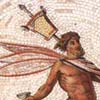 Comte Alexandre de Laborde. Fragmens d'une Mosaïque découverte
à Tarragone, 1802, a hand-colored aquatint. From his
Description d'une pavé en mosaïque d´couvert dans
l'ancienne ville d'Italica (Paris, 1802). This illustration of
a mosaic pavement in Tarragona in northwestern Spain is from a rare volume
of one of the great archaeological documentation publishing projects of
the early nineteenth century. (Prints
and Photographs Division)
Comte Alexandre de Laborde. Fragmens d'une Mosaïque découverte
à Tarragone, 1802, a hand-colored aquatint. From his
Description d'une pavé en mosaïque d´couvert dans
l'ancienne ville d'Italica (Paris, 1802). This illustration of
a mosaic pavement in Tarragona in northwestern Spain is from a rare volume
of one of the great archaeological documentation publishing projects of
the early nineteenth century. (Prints
and Photographs Division)
Taking current European countries as a reference point, one learns that in virtually every case the Library's social sciences and humanities collections are the largest in North America, and at the same time the largest outside the country of origin. Thus, for example, the Library has the largest collection of materials from Spain and relating to matters Spanish outside of Spain itself. The same is true for most of the Eastern European countries and Russia. The Russian collections taken as a whole represent the largest single concentration of Russian materials outside the major repositories of Moscow and St. Petersburg.
Owing to the preeminence of Europe in world affairs between the age of exploration beginning in the fifteenth century and the colonization and settlement of most of the world by European powers, the Library's European collections in the social sciences and humanities are, in effect, worldwide in scope and focus, but at the same time, they are intensely and deliberately national. The collections reflect each European nation's distinctive history, literature, culture, religion, geography, and civilization. The Library collects not only from and about the largest states of Europe--France, Germany, Italy, Russia, Ukraine, and the United Kingdom--but also from and relating to smaller ones such as Denmark, Latvia, Luxembourg, Malta, Portugal, and Slovenia. Moreover, it collects materials by and about minority nationalities and ethnic groups that do not form independent countries--the Basques of France and Spain, the Frisians of Holland and Germany, the Romansh speakers of Switzerland, the Wends of Germany, the Vlachs of the Balkan Peninsula.
 Hartmann Schedel. Liber chronicarum
(Nuremberg, 1493). The Nuremberg Chronicle, the most heavily illustrated
book from the late fifteenth century, is a history of the world told with
a mixture of biblical, mythological, and historical themes. Illustration
no. 290 shows the artist's conception of Portugal. (Lessing
J. Rosenwald Collection, Rare
Book and Special Collections Division)
Hartmann Schedel. Liber chronicarum
(Nuremberg, 1493). The Nuremberg Chronicle, the most heavily illustrated
book from the late fifteenth century, is a history of the world told with
a mixture of biblical, mythological, and historical themes. Illustration
no. 290 shows the artist's conception of Portugal. (Lessing
J. Rosenwald Collection, Rare
Book and Special Collections Division)
Because of wars, revolutions, and general political turmoil in Europe over the past several centuries, large numbers of people have frequently emigrated or been exiled from their homelands and obliged to settle elsewhere on the continent or around the world. Publications of these groups provide an important and essential counterbalance to official materials--often expressing a narrowly "party-line" position--from the home country.
This role of émigré publications holds particularly true for the countries of the former Soviet Union and Eastern Europe, which were ruled by communist governments for many decades, until the late 1980s and early 1990s, and where governments tightly controlled publishing and censored much original research and publication in politically sensitive areas such as history, literary criticism, and political science. The same situation applied in Spain and Portugal until their self-liberation from fascism in the 1970s.
At the core of the Library's European social science and humanities collections lie the thousands of general periodicals and journals and the holdings of reference sources that provide general information, assistance, and specific guidance in using the published literature. For most European countries, the general periodical collections are remarkably complete and include scholarly and literary journals, current-events and news magazines, major daily and weekly newspapers, and the serial publications and transaction journals of learned societies, institutes, and other research centers. The reference collections include encyclopedias, dictionaries, handbooks, directories, bibliographies, biographical sources, gazetteers, atlases, catalogs, and general surveys and guides to countries, subjects, time periods, personalities, and groups.
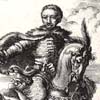 Van der Linde. Leven en daaden van
Johannes Sobietzki de III . . . (Amsterdam, 1685). This handsome
engraving depicts the military hero and future Polish king, Jan III Sobieski,
who in 1683 defeated the Turks at Vi enna. (Rare
Book and Special Collections Division)
Van der Linde. Leven en daaden van
Johannes Sobietzki de III . . . (Amsterdam, 1685). This handsome
engraving depicts the military hero and future Polish king, Jan III Sobieski,
who in 1683 defeated the Turks at Vi enna. (Rare
Book and Special Collections Division)
In history and the other social sciences, the Library has comprehensive collections allowing researchers to study every European country and nationality from the earliest times to the present. As with periodicals, the Library's collections are particularly strong in published primary source documents, often issued serially or in large sets by each country's major research centers and producers of scholarship--the academies, universities, colleges, learned societies and associations, libraries, museums, archives, and the like.
All aspects of history are covered in the European collections, including political, social, cultural, and labor history, as well as biographical literature and the histories of individual disciplines--the history of science, for example. In addition to primary published source documentation, the Library attempts to collect all major secondary historical and historiographical scholarship and, very selectively, popular writings on history.
![Thumbnail Image of "La Bible ([Geneva], 1553)"](images/020001th.jpg) La Bible. ([Geneva], 1553).
The Geneva revision is the first Protestant French Bible. (Bible
Collection, Rare Book
and Special Collections Division)
La Bible. ([Geneva], 1553).
The Geneva revision is the first Protestant French Bible. (Bible
Collection, Rare Book
and Special Collections Division)
All periods of European history are well represented, but the history collections are most comprehensive and complete for modern Europe--the age of exploration and colonization in the fifteenth and sixteenth centuries, the Renaissance and Reformation, the rise of empires, the beginning of the development of national self-identity and consciousness, the period of major revolutions and wars--the French Revolution, 1848, the two world wars, the Russian Revolution--the Cold War, and, finally, the period of East European democratization, the fall of communism, and the development and enlargement of the European Union. For the past twenty years the Library has videotapes of television news broadcasts and documentary films from a number of European countries, including France, Germany, Italy, Poland, the former Yugoslavia, and Russia, to supplement other documentary sources and print materials.
Other disciplines that are critical for historical research--archaeology, paleography, genealogy, numismatics, heraldry, chronology--are well represented. From around the world, the Library collects comprehensively materials on archives and archival holdings relating to Europe and European nationalities.
In the related areas of political science, foreign relations, and law, the Library's European collections emphasize primary source documents such as the minutes of parliamentary meetings and debates, official government gazettes that record decrees and regulations, treaties, laws, court decisions and rulings, and commentaries on legal texts. Holdings in the collections reflect the development of democracy and representative government, beginning in Ancient Greece and continuing through its reemergence in the age of the democratic revolutions. They document its twentieth-century collapse into authoritarianism and totalitarianism in many European countries, up to the restoration of democracy in post-Franco Spain and post-Salazar Portugal in the 1970s and in most of the formerly communist countries of Eastern Europe in the early 1990s.
Geography and travel are amply represented in the Library's collections. Maps and other cartographic materials form the true core of the geography collection, but the Library also comprehensively collects book materials on descriptive, physical, cultural, and social geography. Such materials include travel accounts from the early medieval period to the present, scholarly journals, and individual studies, monographs, and conference reports on geographical topics relating to Europe.
 Vanity Fair Album (London,
1876). Displayed in the album are very fine caricatures of important
personages of the day. The Duke of Connaught, Queen Victoria's third son,
is described by the editors as "quite unspoi lt, and though now over six-and-twenty
his morals are held to be still above all reproach." (Prints
and Photographs Division)
Vanity Fair Album (London,
1876). Displayed in the album are very fine caricatures of important
personages of the day. The Duke of Connaught, Queen Victoria's third son,
is described by the editors as "quite unspoi lt, and though now over six-and-twenty
his morals are held to be still above all reproach." (Prints
and Photographs Division)
 Norbert Goeneutte. Octobre, 1880,
a photogravure. From L'Art de la mode, vol. 1 (1880-81),
facing p. 72. A typical fashion plate from this influential fashion magazine
of the French Third Republic. (Prints
and Photographs Division)
Norbert Goeneutte. Octobre, 1880,
a photogravure. From L'Art de la mode, vol. 1 (1880-81),
facing p. 72. A typical fashion plate from this influential fashion magazine
of the French Third Republic. (Prints
and Photographs Division)
Similarly, publications in the fields of economics, demography, and statistics are strongly represented in the Library's European collections. The economics collection includes all major works in theoretical and practical economics. Works on business and commerce are particularly well represented for the twentieth century, and the Library has a virtually complete collection--in print form or microform--of all statistical yearbooks, census reports and results, and more specialized studies published by every European state.
The study of society itself is represented by the disciplines of sociology, anthropology, ethnology, and folklore. The Library's collections in these disciplines are strong, relating to all European nations and groups. Included, for example, are scholarly studies and monographs, reports of fieldwork and ethnographic investigations, recordings of folk music, collections of folk tales and epics, and theoretical studies related to the theory of society and its functioning.
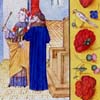 Boethius. De consolatione philosophiae
(Ghent, 1485). This early printed book has many hand-painted illustrations
depicting Lady Philosophy and scenes of daily life in fifteenth-century
Ghent. (Lessing J.
Rosenwald Collection, Rare
Book and Special Collections Division)
Boethius. De consolatione philosophiae
(Ghent, 1485). This early printed book has many hand-painted illustrations
depicting Lady Philosophy and scenes of daily life in fifteenth-century
Ghent. (Lessing J.
Rosenwald Collection, Rare
Book and Special Collections Division)
The Library has extensive collections on each of the languages of Europe, both those spoken by many millions of people, such as English, German, French, Spanish, Russian, Ukrainian, and Polish, and the less widely used languages like Welsh, Maltese, Albanian, Latvian, and Estonian. Holdings for each language include grammars, dictionaries, readers, textbooks for foreigners, and the principal scholarly histories, commentaries, etymological treatments, periodicals, bibliographies, and grammatical and lexical studies.
European Yiddica, Hebraica, and Ladino are particularly strongly represented in the Library's collections. Produced primarily, though not exclusively, in Europe during the nineteenth century, the Yiddish-language collections include approximately 15,000 monographic titles as well as a comprehensive collection of serials and newspapers. Much larger are the Library's Hebraic collections, which contain more than 100,000 titles, ranging from thousand-year-old rabbinic responses to eighteenth- and nineteenth-century haskalah (Jewish Enlightenment) literature. The Hebraic Section of the Library's African and Middle Eastern Division houses a small collection of Hebrew manuscripts as well as broadsides and other documents that reflect on Jewish life in Europe. Especially interesting are Hebrew newspapers published during the nineteenth century. Approximately 600 Ladino titles, many of which were produced in European cities, are also located in the Hebraic Section.
 A
broadside in Yiddish, issued on March 22, 1858, by the representatives
of the Jewish community of Lemberg, informs Jews of Galicia, Cracow, and
Bukovina that the special test for grooms and brides before their marriage,
imposed by royal decree in 1805, has been rescinded by the government.
(Hebraic Section, African
and Middle Eastern Division)
A
broadside in Yiddish, issued on March 22, 1858, by the representatives
of the Jewish community of Lemberg, informs Jews of Galicia, Cracow, and
Bukovina that the special test for grooms and brides before their marriage,
imposed by royal decree in 1805, has been rescinded by the government.
(Hebraic Section, African
and Middle Eastern Division)
The Library's collections in general, theoretical, historical, and synchronic linguistics are also robust, particularly in the area of comparative Indo-European linguistics and its various subdisciplines, such as Romance, classical, and Slavic philology. Since the scientific study of language and languages in the modern period had its beginnings in Europe, the Library's European linguistics collections, in fact, are worldwide in coverage and significance.
The literature collections of the Library of Congress are extremely strong for almost every European country. All European literatures, both of major nations and of smaller ethnic groups, many without their own state, are represented in the Library's collections in the original language and selectively in English translation. The Library collects works of modern literature in various genres--novels, plays, poetry, short stories, and the like--a selection of current authors and popular writers, and materials on the history and criticism of each European literature and of individual European writers. The literature collections in print materials are enhanced by a number of collections of sound recordings, described in the Special Collections section below.
Materials in religion and philosophy are integral to the Library of Congress collections. The four major European religious traditions--Roman Catholicism, Eastern Orthodoxy, Protestantism, and Judaism--are represented not only by the standard editions of basic scriptural and interpretive texts but by a comprehensive selection of commentaries, church histories, polemical and pastoral works, church law and regulations, periodicals, and reference materials. Islam in Europe is also represented, especially by numerous publications on the history and culture of Moorish Spain and the Ottoman Balkans, and, more recently, the Muslim communities in the South Slav countries.
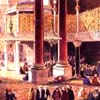 Gaspare Fossati. Aya Sofia
(London, 1852). Plate no. 15 from the portfolio of the Italian architect
hired to restore the mosque of Aya Sofya in Istanbul in the
mid-nineteenth century. This edifice, now serving as a museum, was built
in the sixth century as the Christian church of Hagia Sofia. (Prints
and Photographs Division)
Gaspare Fossati. Aya Sofia
(London, 1852). Plate no. 15 from the portfolio of the Italian architect
hired to restore the mosque of Aya Sofya in Istanbul in the
mid-nineteenth century. This edifice, now serving as a museum, was built
in the sixth century as the Christian church of Hagia Sofia. (Prints
and Photographs Division)
Finally, in the social sciences and humanities, the Library
of Congress makes special efforts at collecting European
materials in the area of book studies, librarianship, and
bibliography. The printed book is, of course, a European
invention, and in addition to a number of special collections--such
as incunabula, early printed Bibles, and illuminated
manuscripts--the Library has strong holdings in materials
relating to the history of printing and publishing in each
country, the development and current state of libraries and
archives, and the field of descriptive and analytical
bibliography. Of particular value to scholars are the Library's
descriptive materials about the major libraries in each European
country.
Library of Congress October 6, 2005 Ask a Librarian |
LC Home Page | Search the LC Catalog | European Reading Room |